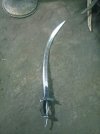Many of the blades used in Indian Tulwars, and other swords, for that matter, were European. Towards the end of the 18th century, and well into the 19th, German and Italian blades were highly sought after. Some were purpose made for Indian trade, with patterns based on traditional models. Others were simply stuck on Indian style hilts as is. Other blades, especially the 1796 LC sabre, were bought up as surplus, and then reshaped to better suit the Indian styles of swordsmanship. This often involved regrinding the edge, thinning the blade to make it more suited to slashing and draw cuts, and sometimes even shortening it. The Wootz steel that India was famed for seems to have been capable of holding a very sharp edge. However, everything I have seen gives me the impression that it was a bit more brittle than more modern (for that period) European steels. That doesn't matter much when your targets tend to be wearing little in the way of metal armor, and parrying with the blade is not a common tactic. But when you are going up against people who are trained to parry with their blade, instead of either using a shield or footwork to avoid the blow, that brittleness can become an issue. It doesn't help you much if your razor-sharp sword, that is fully capable of decapitating an opponent with the flick or your wrist, is now just a stump of a sword sticking out of the hilt because the other guy blocked your attack with his crude, but still serviceable sabre.
Also don't forget that those same swordsmiths in Germany were cranking out all kinds of blades for people all over the world. North Africa, Sudan, the Middle East... It looks like they would make anything for anybody if there was money in it. Judging from the significant number of surviving blades around the world, there was both a demand for the blades at the time, and a very good supply of them being made.




